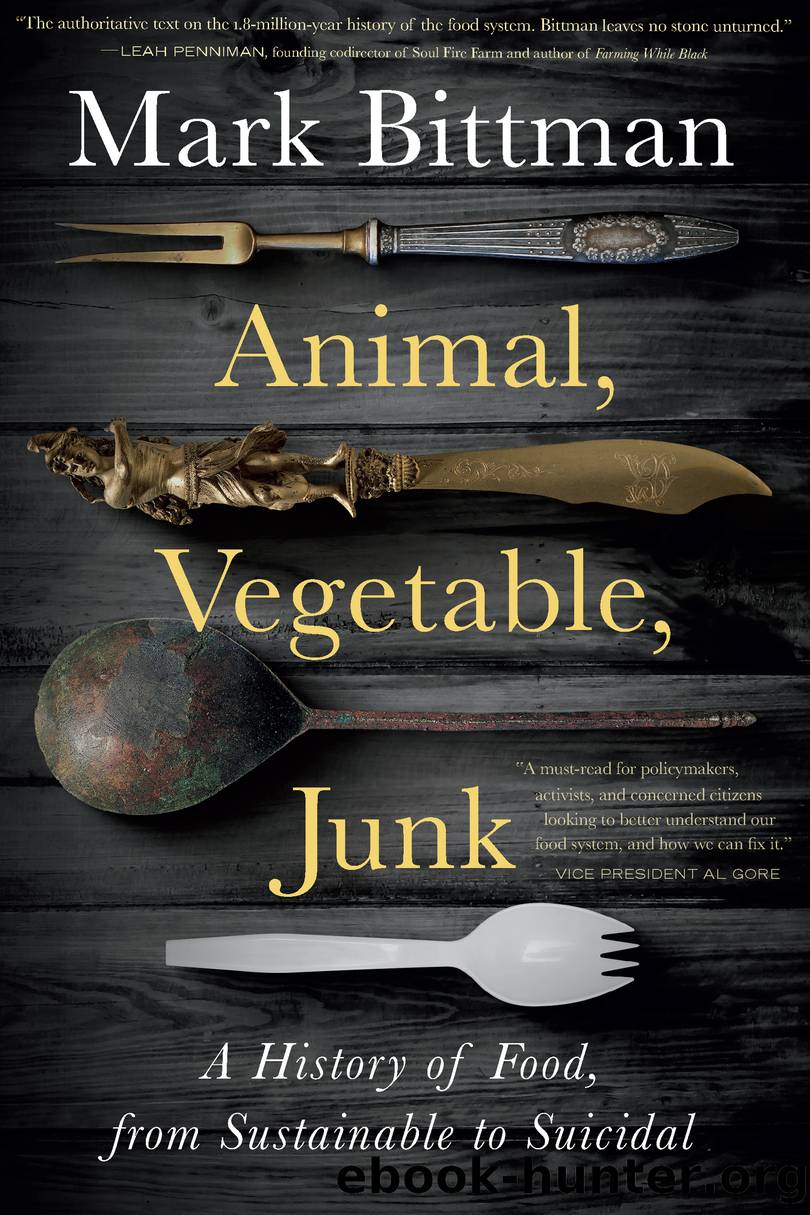Animal, Vegetable, Junk by Mark Bittman

Author:Mark Bittman
Language: eng
Format: epub
ISBN: 9781328971623
Publisher: HMH Books
Published: 2020-12-19T00:00:00+00:00
11
Force-Feeding Junk
SOME AMERICANS MAY remain willfully ignorant of the effects of a hyper-processed, meat-heavy diet, and others (though probably not many) may legitimately remain in the dark. The vast majority understand the risks of overeating fat, animal products, junk food, and so on, despite the lies of Big Foodâs marketing machine and government policies that help make unhealthful foods the most widely accessible. Countering those lies and policies has been among the great challenges of public health advocates.
In 1957, the American Heart Association concluded that diet may play an important role in the development of atherosclerosis, the deposits of plaque that narrow arteries. Furthermore, it found that the fat content and total calories in a diet may be the dominant contributing factors, and that the type of fat, or the balance between saturated and certain unsaturated fats, also may be important.
But the well-intentioned AHA made a couple of crucial mistakes. The first was that, in fine reductionist tradition, its experts didnât talk about food as whole. Rather, they talked about food broken down into individual nutrients: fat, saturated fat, polyunsaturated fat, carbohydrates, and so on. It would have been simpler (and more accurate) to talk about meat, or even âanimal productsââthe source of almost all saturated fat.
The second mistake was that there were other factors besides âfatâ contributing to the increase in chronic disease. Important among them was sugar, which was critically missing from the AHA summary and downplayed or ignored for decades.
We have long known that sugar isnât good for us. Aristotle figured out that it causes tooth decay, and weâve since learned that it contributes to insulin resistance and obesity, diabetes, heart disease, hyperactivity, and more.
Annual per capita consumption of sugar in the U.S. food supply had increased relentlessly, moving from around ten pounds in 1821 to 108 pounds in 1931. But during World War II, when the medical consensus about the nutritional deficiencies of sugar aligned with the militaryâs desire to keep the troops happy with a steady supply while rationing it for civilians, sugar was officially deemed unnecessary on the home front. The American Medical Association advised âthat even a substantial curtailment of sugar is likely not to injure the nutrition of the American people.â The government put it better. One official pamphlet screamed, âHow Much Sugar Do You Need? None!â
We might have needed ânone,â but by the seventies, the development of high-fructose corn syrup (HFCS)âa sugar equivalent thatâs virtually identical in taste, habit-forming properties, and treatment by the human bodyâallowed for a significant increase in consumption.
HFCS was created by a novel wet milling process (most grain is milled dry), which Archer Daniels Midland (ADM) invested in heavily. Its production yielded a by-product, ethanol, and together these went on to become complementary industry boondoggles.
Corn ethanol, a form of alcohol, powered some early automobiles, including the Model T. But it truly started to gain traction when ADM began producing high-fructose corn syrup in quantity while the Nixon, Ford, and Carter administrations were pursuing energy independence after gas prices rose following the OPEC embargo.
Download
This site does not store any files on its server. We only index and link to content provided by other sites. Please contact the content providers to delete copyright contents if any and email us, we'll remove relevant links or contents immediately.
A Court of Wings and Ruin by Sarah J. Maas(7653)
The Death of the Heart by Elizabeth Bowen(3552)
The Sprouting Book by Ann Wigmore(3543)
Better Homes and Gardens New Cookbook by Better Homes & Gardens(3525)
BraveTart by Stella Parks(3395)
Salt, Fat, Acid, Heat: Mastering the Elements of Good Cooking by Nosrat Samin(3108)
Sauces by James Peterson(3051)
Kitchen confidential by Anthony Bourdain(3010)
The Bread Bible by Rose Levy Beranbaum(3004)
Classic by Mary Berry(2942)
Solo Food by Janneke Vreugdenhil(2930)
Ottolenghi - The Cookbook by Yotam Ottolenghi(2871)
Martha Stewart's Baking Handbook by Martha Stewart(2796)
Day by Elie Wiesel(2720)
Betty Crocker's Good and Easy Cook Book by Betty Crocker(2681)
The Plant Paradox by Dr. Steven R. Gundry M.D(2548)
My Pantry by Alice Waters(2547)
The Kitchen Counter Cooking School by Kathleen Flinn(2489)
Hot Sauce Nation by Denver Nicks(2451)
